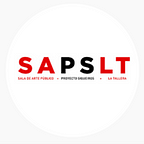Paisaje Polidimensional. Francisco “Taka” Fernández
Over the last several decades “Taka” Fernández has developed an expanded painting practice that layer’s imagery drawn from multiple aesthetic sources. These include historical landscape painting, graffiti, street posters, urban signage, and geometric abstraction from the post-war period. With his commission for the Sala de Arte Público Siqueiros (SAPS), Fernández has engaged all of the institution’s exhibition spaces, moving from the façade of the building, into the patio where the museum’s historical murals are displayed, to the Cube space at the far end of the building. In each of these areas, through painting and sculptural interventions, the artist constructs conversations between his practice and both the formal and conceptual legacies of David Alfaro Siqueiros.
Siqueiros’ commitment to social and political action has inspired Fernández to explore his own political trajectory and to attempt the articulation of a “political self-portrait” with this project. In his early years Fernández was influenced by liberation movements pursued in Latin America during the 70s, then as a teenager in the 80s by punk and anarchism, the latter through the writings of the Italian Errico Malatesta.
Later in the same decade, through experiences in the desert of San Luis Potosí, he began to engage with both indigenous spiritual practices and political struggles, interests that led to his involvement in the Zapatista movement, beginning in the mid-90s. The landscape of Mexico, as a site of both needed political involvement, in terms of environmental and land rights activism, as well as a space of retreat and a site to enact a form of “counter-politics,” continues to inform Fernández political views. This personal history is represented at SAPS through both known and enigmatic symbols the artist depicts, as well as through evocative texts, names and dates he has chosen to include.
The project forms part of the museum’s curatorial program Murales para un cubo blanco (Murals for the White Cube), which places in dialogue the contrasting traditions of 20th century muralism with its emphasis on the socio-political role of art, and that of the White Cube associated with an “art for art” perspective, one understood as separated from social or political engagement.
Both these aesthetic contexts have associated temporalities, with murals physically and conceptually seeking permanence, a forever in situ, while the autonomous works placed in the White Cube have a portability that give this site an implied transience. Fernández’ project plays with both these traditions and their temporalities in complex ways. His multi-part installation includes autonomous paintings and objects that can be placed in other contexts after their display at SAPS.
These works however are imbedded within an overall ephemeral mural context here, layered within massive paintings executed directly on the museum’s walls. These murals will only exist for the period that the project is on view, after which time they will be painted over and the space returned to its normal appearance, one associated with the White Cube. In both his autonomous pieces and murals Fernández’s plays homage to two key concepts Siqueiros developed over the course of his career, the first being poliangularidad, by structuring linear perspectival lines that challenge the physical architecture of the space, and the second being the concept of una caja plástica, through his interest in generating entire environments, spaces that provoke dynamic interactions with the viewer.
Taka Fernández’s hanging sculpture positioned in this space references Mexica cosmologies, with its two cones depicting two distinct universes expanding and contracting. These realities are said to have intersected in the historical past, in a kind of “big bang” event, which created our present moment, but are also understood as parallel universes that currently co-exist and interact in various ways. The piece is titled Olin, which is the Mexica word for “movement,” while additionally signifying spirits or portals that offer movement between these distinct times and spaces.
The piece was originally produced in 2016, as part of a project-residency the artist pursued independently on the Lago de Manialtepec in Oaxaca, which involved a floating drawing studio titled Estacion flotante de contemplación active (Floating station for active contemplation) and the exhibition of this sculpture at the lake. In the current gallery the sculpture’s circles and perspectival lines dialogue with similar forms in the permanent murals of David Alfaro Siqueiros.
In this gallery, as part of his overall articulation of a “political self-portrait” at SAPS, Taka Fernández has produced a collage-like mural. It includes a series of painted portraits that depict philosophers, activists and cultural figures that have influenced the artist’s political development over the last four decades. Moving counterclockwise, the portraits represent the following historical figures:
David Alfaro Siqueiros (1886–1974)
Leon Trotsky (1879–1940)
Ho Chi Minh (1890–1969)
Piotr Kropotkin (1842–1921)
La Comandanta Ramona (1959–2006)
Karl Marx (1818–1883)
Che Guevara (1928–1967)
Mijaíl Aleksándrovich Bakunin (1814–1876)
Lucio Cabañas (1938–1974)
Ricardo Flores Magon (1873–1922)
Emiliano Zapata (1879–1919)
Joe Strummer (1952–2002)
Curator: Tobias Ostrander
